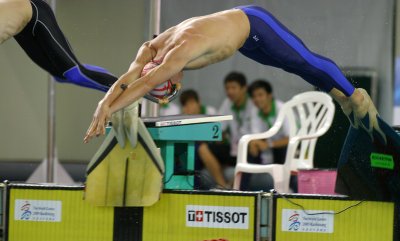Frequently Asked Questions
What shall I do if
- my legs cramp up?
The fins have been designed to execute perfect kick, therefore it increases the strain to the ankle and feet. Beginners might get cramp in their feet. In such cases remove the fin, stretch back your feet, then do some (100-200 metres) easy breaststroke swim. You have to gradually make your feet get used to the fins.
- the fins bruise my feet?
Fins can bruise the feet. This can be avoided by the use of wetsuit socks, or even by using normal ankle socks. However, professional finswimmers do not use any of these, as at competitions time is of highest importance. The direct contact between the feet and the fins are very important – after all violinists do not play the violin wearing gloves either. Professional finswimmers use plasters to protect their bruised feet. During the daily use the fins and the feet adapt to each other and the fins become very comfortable. They do not bruise or squeeze the feet anymore. After missing several weeks of training session, however, you have to get used to the fins again.
- the fins get torn?
No problem! As it is fully made from rubber, unlike silicone fins available in shops which cannot be repaired, the Murena rubber fin can be easily repaired. Keen DIY people can fix their fins at home using rubber patches cut out from inner tubes. However, if you require professional repair, please get in touch with our company. For the repair we use an SC 2000 type glue. You could repair your fins at any helpful garage which specializes in fixing tyres. Professional repair does not reduce the efficiency of the fins. The lifespan of the Murena fin can be extended to a decade even when it is used on a daily basis.
- water pours into my snorkel?
This is absolutely natural – after all, the snorkel is not closed. This is a very simple piece of sports equipment. It is designed for easy airflow. That is the reason why there isn’t any mouthpiece or valve on it. Also these would decrease efficiency by a large extent. Once the correct way of breathing has been mastered, it is very easy to use. If the pipe fills up with water, put your tongue against the end of the pipe and with a strong blast you can blow the water out from the pipe. The use of this sports equipment improves the performance of breathing muscles. A professional finswimmer blows out the water, as with each kick with the monofin water gets into the snorkel. Of course, after a while you do not have to concentrate on this, as it will become natural. Within a few weeks even 6-year-old children learn the proper use of the snorkel.
- water goes into my nose?
Breathing while under water is a bit unusual at the beginning – after all we are not fish. It is quite common that people try to breath through their noses and mouths when their head is in the water. Breathing is done through the mouth using the snorkel. If somebody tries to breath in through their nose, it will result in their noses being washed through – which is not very pleasant. So breathing in takes place through the mouth, breathing out through the nose and the mouth. You can use a noseclip or a finswimming mask, which covers your nose, therefore the problem of breathing is solved. However, it is advisable to master the right breathing method with the nose not being covered, as performancewise it is much more effective to breathe out through the nose.
- Which flexibility grade shall I choose?
We recommend grade 1 fins for those whose ankle joint is fairly stiff or for those who keep cramping up in their feet.
However, if you really want to improve our performance then you should use grade 2 fins. Gradually make your feet get used to the fins, so that you could enjoy swimming at the fastest possible speed you can manage.
However, if you really want to improve our performance then you should use grade 2 fins. Gradually make your feet get used to the fins, so that you could enjoy swimming at the fastest possible speed you can manage.
- How much shall I swim in one go with my fins on?
At the beginning it is advisable to only do 400-600 meters, then removing the fins and doing a few lengths of easy swim. Then gradually we can get used to the fins and it is possible to swim 10 km in one go with the fins on. For professional finswimmers this is normal.
- Can I do breaststroke with the fins?
The standard breaststroke kick can be executed best without fins. However, we can perform wonderful exercises in fins using dolphin or frontcrawl kicks and breast arms.
- How shall I dive with the fins on?
The same way as without fins, however, you should do the traditional (not the track) start, when both feet are in line and your toes are approximately 2-3 cm off the starting block.
- How shall I tumbleturn with the fins on?
The tumbleturn should be done exactly the same way as without fins. It is advisable, however, to touch the wall with full feet and after push off to do 4-5 fly kicks underwater. This increases efficiency extensively and increases the dynamic anaerob capacity by large.
- Why are the fins so short?
There is an optimal length for fins. If they are too long, they won’t follow the movement of the legs. When kicking downwards, too long fins bend – our feet is moving down but the end of the fin is still high; by the time it starts moving downwards, we are already pulling our feet upwards. The result of this would be arhythmical kick which would be imcompatible with the arm strokes.
If your fins are too short, they do not function as fins, they do not help you move forward, therefore there is no point in using them.
The form, length and flexibility of the Murena rubber fins are the result of a long designing process. The testing and improving was done by top finswimmers.
If your fins are too short, they do not function as fins, they do not help you move forward, therefore there is no point in using them.
The form, length and flexibility of the Murena rubber fins are the result of a long designing process. The testing and improving was done by top finswimmers.
- How shall I dive with the snorkel on?
By diving the position of your arms is of utter importance. Already when in the air, swimmers hold their arms together above their heads, so the upper part of the pipe is firmly fixed between the two arms, as if in a clamp. With the perfect hand position it is possible to execute a perfect dive even without the rubber strap on the snorkel.


- How shall I tumbleturn with the snorkel on?
Do your tumbleturn as normal. After pushing off and having done the underwater dolphin kicks, make sure that you only blow out the water from your snorkel, when you feel that you are already on the surface of the water.
- How shall I store my equipment appropriately?
It is advisable to store both the fins and the snorkel in such as way that the water can drip from them, therefore they can get dry, otherwise these equipments might develop mould. It is practical to store your fins in a well-ventilated mesh bag. In case you keep your fins in a carrier (plastic) bag, make sure that your fins are absolutely dry. Keep your fins away from sunlight. Strong sunlight might damage things made from rubber, therefore it is not good for your fins either.
It is highly advised not to leave your fins on the parcel shelf of your car on a scorching summer day.
It is highly advised not to leave your fins on the parcel shelf of your car on a scorching summer day.




